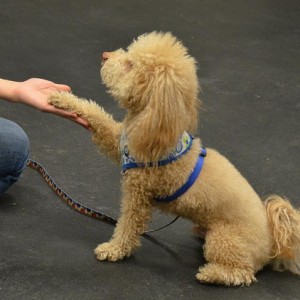 One of the things that makes training dogs so interesting to me is the variety of ways you can teach a dog to do something. After all, if there was only one way to teach my dog something, there wouldn’t be so many books and DVDs and articles to show me how to do it. You see, there are many ways to teach my dog to “Sit” or “Stay.” But does that mean that all of those methods produce the same results? Oh, they will all get my dog to “Sit” or “Stay” but what makes one method different from another?
One of the things that makes training dogs so interesting to me is the variety of ways you can teach a dog to do something. After all, if there was only one way to teach my dog something, there wouldn’t be so many books and DVDs and articles to show me how to do it. You see, there are many ways to teach my dog to “Sit” or “Stay.” But does that mean that all of those methods produce the same results? Oh, they will all get my dog to “Sit” or “Stay” but what makes one method different from another?
These seem like simple questions. But the answers might be more complex if we look beyond the immediate results (did the dog SIT). Science has discovered that our dogs are always observing their environment and may sometimes make associations we don’t expect. This can be especially true when we are trying to teach them something new. That means that how we teach our dog to SIT might give us more than we wanted.
Ready SIT go!
Let’s look at a couple of examples of teaching a SIT behaviour. One of the more popular methods for teaching a dog to SIT involves using a food treat as a “lure” to get the dog to perform the behaviour. The process is to hold the treat above the dog’s head and move it back over them so that they naturally raise their head and put their butt on the floor as they follow the treat with their gaze. When the dog SITS, give them the treat. Another popular method involves using physical guidance to get my dog to sit. This method involves either pressing gently on my dogs lower back near the tail or tugging gently upward on their collar to encourage the dog to get into the SIT position. The dog can then be rewarded with food or praise.
Both of these examples offer opportunities for my dog to learn things beyond just the SIT behaviour. In the lure example, I am also teaching my dog to pay attention to my hand. My dog could become very hand focused and might not work for me if I don’t have something in my hand. In the physical assistance examples, my dog learns that they must tolerate being physically pushed or pulled in order to get the reward. This might be difficult for some dogs who don’t naturally like physical contact (this can be especially true of rescue or shelter dogs with unhappy pasts).
In both cases, I will have taught my dog to SIT but there is more to the picture than just the act of sitting. Everything they experience during the training might teach them something. So how I train might have as much of an impact as what I’m teaching. What happens if my dog doesn’t learn quickly enough? Do I get frustrated and push or pull harder to get the behaviour? Do I try other physical manipulations? Do I hold back the treat until my dog gets frustrated? Is my dog confused or discouraged by not succeeding often enough? From my dog’s perspective, there might be a lot going on here and they could be learning from all of it.
Now let’s look at the other side of the training situation. Teaching a dog to SIT seems like a relatively simple task. But let’s look at a few things the dog has to consider. In order to SIT correctly, my dog must put her butt on the floor. But is there a particular way I want her to do that (e.g. straight, not rolled onto one hip)? How quickly after hearing the cue to “Sit!” is acceptable? How long does she have to stay in that position in order to be correct? If I move, should she still remain in her SIT? Should she SIT if I give the cue from across the room and not just if I am standing in front of her? What about different locations? Does she have to SIT at the park? The back yard? The vet’s office? All of these answers must be communicated to my dog. Do the methods I use to train take all of this into account or do I just “fix it” as I go along?
Unless I’m proactive in giving her the answers to those questions in training, there will be times when my dog thinks she’s doing what is expected and I have to tell her that she’s incorrect. In effect, she will be punished for doing what she thinks is expected. I think that it’s wise to consider what this might lead to if it happens often enough with my dog. So is it fair to decide that a training technique “works” just based on whether my dog’s butt hits the floor? It seems to me that there might be a little more to it if I were to define “success” accurately.
But it works!
“Sit” is a fairly simple behaviour with pretty easy to define criteria. What about more complicated behaviours and situations? Does my training take everything I want into account or do I “fix it” as I go along? One of the more common things I see is when the training stops after the desired results appear to have happened. Whatever the method used, once the basic criteria is met, the trainer stops working with the dog on and assumes that their dog has “got it.” It has happened in my own work with my dogs that I have “finished” training something only to discover that my dog didn’t quite learn what I intended to teach but it was close enough to fool me.
One example of this was when I was teaching my dog to do weave poles for agility. I needed to teach her weave in and out of 6 poles with the first pole on her left shoulder and not stopping until she had completed all 6 correctly. The method I chose to teach her used 3 sets of 2 poles that were initially positioned in a line so that she would run straight through all 3 as if in a hallway. I was to progressively angle the uprights a little at a time so that they would more and more begin to resemble a straight line of poles. I was to reward my dog after she completed moving through all 6 poles.
Near the end of that training, when the poles were just a few degrees off of being a true straight line. I decided to try my dog on a real set of weave poles that were already arranged in a proper straight line. I pointed and my dog dutifully ran straight to the last opening, bypassing 4 poles, and went through happily and returned for her expected reward. So, that didn’t quite go as planned. My dog had learned something very different from what I intended to teach even after all that careful work. I could say the training “worked” but not in the way I expected. Or it “didn’t work”, depending on how I wanted to look at it.
There are a lot of ways to teach a dog behaviours. And pretty much every one of them will “work” to one degree or another. The question becomes, what does “it works” mean to you? As I have developed my skills as a trainer over the years, my own personal definition of “it works” has expanded beyond just “did they physically do what I asked.” These days I’m concerned with additional things. I want my dogs offer me behaviours when I ask for them, not simply comply to avoid unpleasant consequences. I want my dogs to be willing to offer me trained behaviours in a variety of environments and circumstances, even new ones we may never have encountered before. I want my dogs to happily respond to my cues as quickly and eagerly 10 years from now as they do today.
Not attending to all of that extra criteria and taking it into account could cost me little pieces of any or all of those long-term goals. The methods I use to train my dog are important to that process. But just as important is my skill in using them. Doing enough of the training to get to a point where I can say “good enough” might not, in fact, be good enough. I should be doing my homework to understand how and why a training method works and make sure that I have the right skills to do it properly. Not just until I get something that looks like “it works.”
I understand that not every dog owner is as passionate about training and teaching dogs as I am. Not everyone has the same standards or skill sets when working with their dogs. But I think it comes down to expectations. So long as we set our expectations correctly and recognize what the skills and methods we have to work with can do, I think every dog owner can have a long and happy life with their dogs. Just be careful of people who want to share their training secret with you because “it works.” They may have a very different standard for that phrase than you do!
Until next time, have fun with your dogs!
Be sure to check out our Canine Nation ebooks in the Canine Nation store and Dogwise. Join our conversation on Facebook in the Canine Nation Forum!
These Canine Nation ebooks are now available –
Photo credits –
Lament – John Lawlor copyright 20011 from Flickr
One Hip – localpups copyright 2015 from Flickr
Training Class – Andrea Arden copyright 2013 from Flickr







I cannot believe you wrote all of that without once using the actual word for what, to me, should be common knowledge for an actual trainer. A behavior or skill is not properly learned until it has been thoroughly proofed. Do trainers no longer know to do this??? You teach sit in the living room… and the kitchen, the back yard, the front yard, down the block, at your friend’s house, at the pet store. You teach sit by yourself… and with other people present, with other dogs present, with a cow over there, with a balogna sandwich on the floor. You teach sit with your dog facing you in front… and with your back to the dog, with you sitting on the couch, with you lying on the floor, with you in the other room, with your dog over there. You teach sit until your dog says, “Oh! You mean EVERYWHERE! Even in a puddle! Every time!” THEN, you have taught your dog to sit.
Thanks for reading!
Personally, I prefer the term “making a behaviour fluent” or “generalising” a behaviour but, yes, the concept of “proofing” is alive and well. Since I write these articles to appeal to a broad audience, I try to avoid using terms if I don’t take the time to explain. So, yes, “proofing”, “generalising”, “teaching to fluency” – very important part of any dog training!
Thanks,
Eric